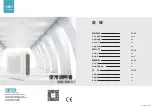
Samsung Electronics
218
Piping Diagram
7-3-1 Basics
7-3-1-1 P-h Diagram
P-h Diagram
In the following P-h diagram, the horizontal and vertical axes indicate enthalpy and pressure respectively.
This diagram shows material properties for refrigerant.
▪
The process where gas refrigerant becomes liquid refrigerant is called condensation.
The process where liquid becomes gas is called evaporation. The process where gas becomes liquid or vice versa is called
phase change.
▪
The temperature where the phase changes is called saturation temperature.
The saturation temperature depends on the refrigerant type and pressure. Saturation temperature properties can be viewed
using the saturation curve in the P-h diagram.
▪
Pressure-specific temperature, also called isothermal line, is shown in the P-h diagram.
It is possible to view the refrigerant status by locating the point that is intersected by the pressure and isothermal lines and
divided by the saturation curve. The intersecting point can be derived by measuring refrigerant temperature and pressure at
a certain point.
▪
Refrigerant consisting of a single component does not have a temperature gradient during the phase change process.
Refrigerant mixtures may have a temperature gradient during the phase change process, as the saturation temperature for
components of the refrigerant vary.
This type of refrigerant is called non-azeotropic refrigerant. R410A refrigerant is referred to as a near-azeotrpic refrigerant.
▪
Superheated vapor indicates to the vapor state found to the right of the Saturated vapor line.
▪
Two-phase state refers to a state where gas and liquid phases are mixed.
▪
Subcooled liquid refers to the liquid state found to the left of the Saturated liquid line.
7-3 Functions
















































